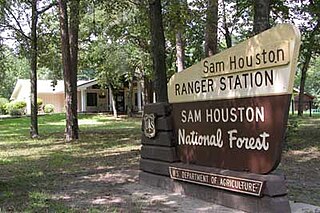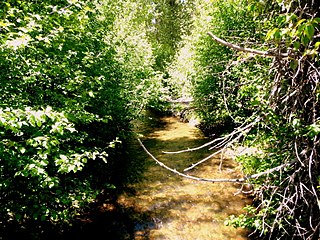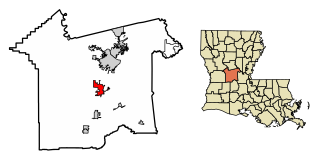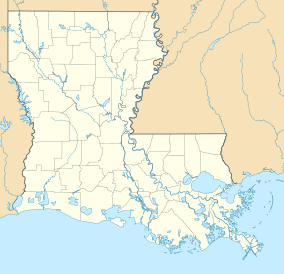
Henslow's sparrow is a passerine bird in the Passerellidae family. It was named by John James Audubon in honor of John Stevens Henslow. It was formerly classified in the genus Ammodramus.

The longleaf pine is a pine native to the Southeastern United States, found along the coastal plain from East Texas to southern Maryland, extending into northern and central Florida. It reaches a height of 30–35 m (98–115 ft) and a diameter of 0.7 m (28 in). In the past, before extensive logging, they reportedly grew to 47 m (154 ft) with a diameter of 1.2 m (47 in). The tree is a cultural symbol of the Southern United States, being the official state tree of Alabama and the unofficial state tree of North Carolina.

The red-cockaded woodpecker is a woodpecker found in southeastern North America. Some taxonomic authorities, including the American Ornithological Society, continue to place this species in the genus Picoides.

Flatwoods, pineywoods, pine savannas and longleaf pine-wiregrass ecosystem are terms that refer to an ecological community in the Southeastern coastal plain of North America. Flatwoods are an ecosystem maintained by wildfire or prescribed fire and are dominated by longleaf pine, and slash pine in the tree canopy and saw palmetto, gallberry and other flammable evergreen shrubs in the understory, along with a high diversity of herb species. It was once one of the dominant ecosystem types of southeastern North America. Although grasses and pines are characteristic of this system, the precise composition changes from west to east, that is, from Texas to Florida. In Louisiana, savannas even differ between the east and west side of the Mississippi River. The key factor maintaining this habitat type is recurring fire. Without fire, the habitat is rapidly invaded by other species of woody plants.

Kisatchie National Forest, the only National forest in Louisiana, United States, is located in the forested piney hills and hardwood bottoms of seven central and northern parishes. It is part of the Cenozoic uplands and has large areas of longleaf pine forests. It is one of the largest pieces of natural landscape in Louisiana, with some 604,000 acres (2,440 km2) of public land, more than half of which is vital longleaf pine and flatwoods vegetation. These support many rare plant and animal species. There are also rare habitats, such as hillside seepage bogs and calcareous prairies. The forest also contains and provides a buffer for the Kisatchie Hills Wilderness, a nationally designated wilderness area that contributes to protecting biodiversity of the coastal plain region of the United States.

Picayune Strand State Forest is one of 37 state forests in Florida managed by the Florida Forest Service. The 78,000-acre forest consists primarily of cypress swamps, wet pine flatwoods and wet prairies. It also features a grid of closed roads over part of it, left over from its previous land development schemes.

Tall Timbers Research Station and Land Conservancy is a research and learning facility located in northern Leon County, Florida, just off County Road 12 on the north side of Lake Iamonia. Occupying the same acreage and location and operating from the old Beadel House, Tall Timbers researches the areas of fire ecology, resource management, forestry, game bird management, and vertebrate ecology.

The Sam Houston National Forest, one of four National Forests in Texas, is located 50 miles north of Houston. The forest is administered together with the other three United States National Forests and two National Grasslands located entirely in Texas, from common offices in Lufkin, Texas. The units include Angelina, Davy Crockett, Sabine, and Sam Houston National Forests, plus Caddo National Grassland and Lyndon B. Johnson National Grassland. There are local ranger district offices located in New Waverly.

Sun Pass State Forest is one of six state forests managed by the Oregon Department of Forestry. The forest is located 40 miles (64 km) north of Klamath Falls, Oregon near the southeastern corner of Crater Lake National Park. It is the largest single block of Oregon state forestry land east of the Cascade Mountains. The forest is managed as part of the Klamath-Lake District, comprising 21,317 acres (86.27 km2) of the 33,739 state-owned acres within the district.

The eastern savannas of the United States covered large portions of the southeast side of the continent until the early 20th century. These were in a fire ecology of open grassland and forests with low ground cover of herbs and grasses.

Upper Ouachita National Wildlife Refuge was established in 1978 and is located Union and Morehouse Parishes in northern Louisiana.

Piedmont National Wildlife Refuge is a 35,000-acre (140 km2) National Wildlife Refuge established in 1939 and located in central Georgia. It is primarily an upland forest dominated by loblolly pine on the ridges with hardwoods found along the creek bottoms and in scattered upland coves. Clear streams and beaver ponds provide ideal wetland habitat for wood ducks and other wetland dependent species. In the early 19th century the European settlers arrived in abundance and began to clear the land to plant a variety of crops. The settlers removed more than 90% of the forest. The continuous planting of cotton caused serious erosion and soil infertility. By the late 1870s they had abandoned more than a third of the land because the land could not sustain crops.

Big Woods State Forest is a 2,188-acre (8.85 km2) state forest in Sussex County, Virginia. It was the first state forest property to be established in southeast Virginia.

The longleaf pine ecosystem is a diverse climax temperate coniferous forest habitat that includes many rare plant and animal species found within the southeastern United States, and is one of the most biodiverse in North America. Once a dominant ecosystem of the southeastern portion of the United States, it now occupies less than a quarter of the original range. Degrading of the ecosystem is partially due to excessive timber harvesting, urbanization, and fire exclusion. Although the ecosystem is heavily fragmented in present time, it still carries a great diversity of plant and animal species, many of which are endemic. The greatest current concern for the ecosystem is the continuation and health of the overall plant and animal species which reside within the area. The use of a range of techniques, including planting longleaf seedlings, introducing prescribed burning regimens, managing native ground cover, and controlling invasive species within the ecosystem can help to preserve this threatened ecosystem.

The fauna of the State of Louisiana is characterized by the region’s low swamplands, bayous, creeks, woodlands, coastal marshlands and beaches, and barrier islands covering an estimated 20,000 square miles. Southern Louisiana contains up to fifty percent of the wetlands found in the Continental United States, and are made up of countless bayous and creeks.

Big Woods Wildlife Management Area is a 4,173-acre (16.89 km2) Wildlife Management Area (WMA) in Sussex County, Virginia. It comprises two tracts of land; the 2,208-acre (8.94 km2) main tract, located immediately adjacent Big Woods State Forest, and the 1,965-acre (7.95 km2) Parker's Branch tract, located nearby.

Peason Ridge Wildlife Management Area, also referred to as Peason Ridge WMA, is a 74,309 acre tract of protected area located in the Parishes of Natchitoches, Sabine, and Vernon, in the state of Louisiana. The WMA is managed by the Louisiana Department of Wildlife and Fisheries (LDWF).

"This is a traditional gathering place for over a century, and is maintained on Sand Hills State Forest as a family recreational area. Known locally as "The Mountain", Sugarloaf is an unusual geological phenomenon towering a hundred feet above the surrounding terrain."

























